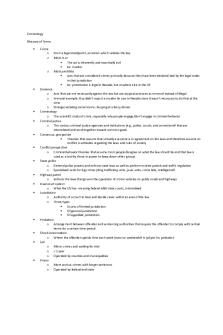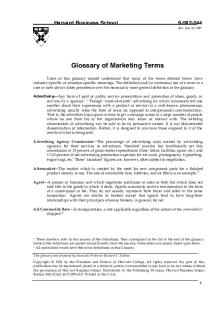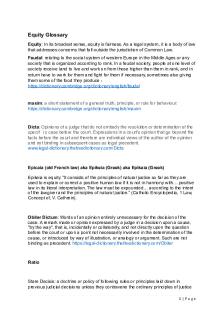Physics Glossary (WEP\'S) PDF

| Title | Physics Glossary (WEP\'S) |
|---|---|
| Author | Alex Storey |
| Course | Engineering Mechanics |
| Institution | Loughborough University |
| Pages | 2 |
| File Size | 66.5 KB |
| File Type | |
| Total Downloads | 57 |
| Total Views | 138 |
Summary
Download Physics Glossary (WEP'S) PDF
Description
Physics Glossary (WEP’S)
Electric Current: Is a flow of charge due to the passage of charged particles Conventional Current: Charge carriers are electrons in a metallic conductor, which flow from negative to positive. Early experiments with electricity did not know the electron existed and arbitrarily defined current as a flow of positive charge.
Coulomb: Unit of electricity equal to the charge flow in 1 second when the current flowing is 1 ampere.
Mean Drift Velocity: Average speed charge carriers move through a material in a certain direction.
Insulator: Doesn’t conduct electricity, has no charge carriers free to move. Electromotive force: The electrical energy transferred per unit charge when one other type of energy is converted into electrical energy.
Internal resistance: Is the loss of potential difference per unit current in the source, when current passes through the source (resistance inside a source of electrical energy due to the opposition of the flow of charge)
Charge carriers: Charged particles that move through a material when a P.D. is supplied across it
Ohm’s Law: The P.D. across a metallic conductor is proportional to the current through it provided the physical conditions do not change.
Thermistor: A resistor which is designed to have a resistance that changes with temperature (usually decreases as temperature increases)
P.D: Is energy per unit charge converted from electrical energy into other forms (work done) Kirchoff’s First Law: At any junction in a circuit, the total current leaving the junction is equal to the total current entering the junction.
Kirchoff’s Second Law: For any complete loop of a circuit, the sum of e.m.f.s around the loop is equal to the sum of potential drops around the loop.
Voltage: P.D. between any two points in a circuit is defined as: the energy transfer per coulomb of charge that flows from one point to another.
Difference between P.D. and E.M.F: Voltage is energy transfer (work done) per unit charge in the load (or connected devices) in a circuit / EMF is energy transfer per unit charge in the battery or power supply.
Kilowatt-Hour: A unit of energy equal to a power of 1000 W consumed over the period of 3600 seconds.
Ramshaw
Resistivity: Resistance per unit length (x) area of cross-section… (Property of a material) Resistance: Potential difference (/) current... (Property of an object, taking dimensions into account)
EMF: of a source of electricity is defined as the electrical energy per unit charge produced inside the source.
Ampere: is defined in terms of the force between 2 parallel wires when they pass the same current.
Potential Divider: Is the ratio of P.D’s across each resistor equal to the resistance ratio of the 2 resistors.
Ramshaw...
Similar Free PDFs

Physics Glossary (WEP\'S)
- 2 Pages

Glossary
- 2 Pages

Glossary
- 2 Pages

Criminology glossary
- 5 Pages

Psychology glossary
- 64 Pages

ATS1310 Glossary
- 1 Pages

MKT Glossary
- 24 Pages

Glossary Equity
- 2 Pages

Project-management-glossary
- 12 Pages

English (Advanced) HSC Glossary
- 2 Pages

Glossary of psychiatric terms
- 26 Pages

Geography Unit 3 Glossary
- 3 Pages

Biological Psychology 1- Glossary
- 10 Pages

LFS112 Week 1 Glossary
- 3 Pages

Rstudio - glossary and tips
- 3 Pages

Language features glossary
- 4 Pages
Popular Institutions
- Tinajero National High School - Annex
- Politeknik Caltex Riau
- Yokohama City University
- SGT University
- University of Al-Qadisiyah
- Divine Word College of Vigan
- Techniek College Rotterdam
- Universidade de Santiago
- Universiti Teknologi MARA Cawangan Johor Kampus Pasir Gudang
- Poltekkes Kemenkes Yogyakarta
- Baguio City National High School
- Colegio san marcos
- preparatoria uno
- Centro de Bachillerato Tecnológico Industrial y de Servicios No. 107
- Dalian Maritime University
- Quang Trung Secondary School
- Colegio Tecnológico en Informática
- Corporación Regional de Educación Superior
- Grupo CEDVA
- Dar Al Uloom University
- Centro de Estudios Preuniversitarios de la Universidad Nacional de Ingeniería
- 上智大学
- Aakash International School, Nuna Majara
- San Felipe Neri Catholic School
- Kang Chiao International School - New Taipei City
- Misamis Occidental National High School
- Institución Educativa Escuela Normal Juan Ladrilleros
- Kolehiyo ng Pantukan
- Batanes State College
- Instituto Continental
- Sekolah Menengah Kejuruan Kesehatan Kaltara (Tarakan)
- Colegio de La Inmaculada Concepcion - Cebu